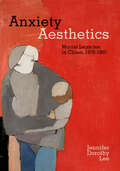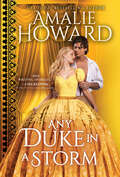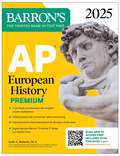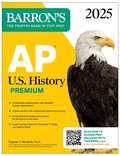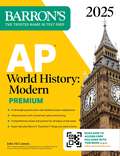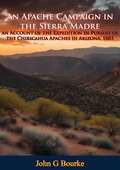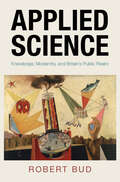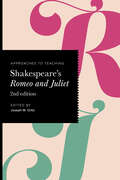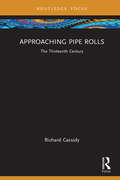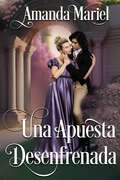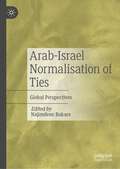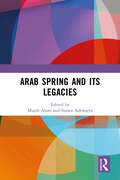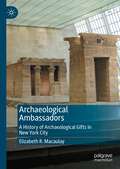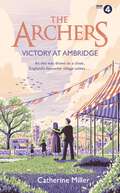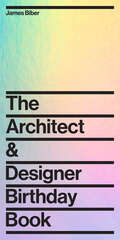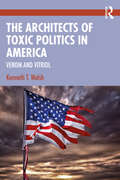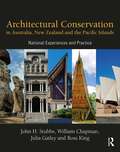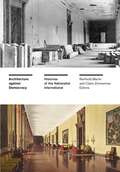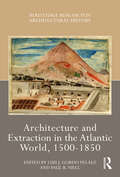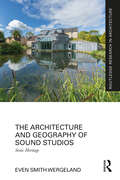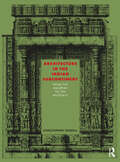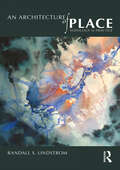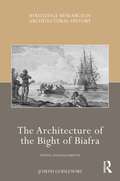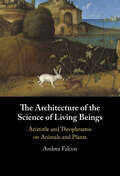- Table View
- List View
Anxiety Aesthetics: Maoist Legacies in China, 1978–1985
by Jennifer Dorothy LeeAnxiety Aesthetics is the first book to consider a prehistory of contemporaneity in China through the emergent creative practices in the aftermath of the Mao era. Arguing that socialist residues underwrite contemporary Chinese art, complicating its theorization through Maoism, Jennifer Dorothy Lee traces a selection of historical events and controversies in late 1970s and early 1980s Beijing. Lee offers a fresh critical frame for doing symptomatic readings of protest ephemera and artistic interventions in the Beijing Spring social movement of 1978–80, while exploring the rhetoric of heated debates waged in institutional contexts prior to the '85 New Wave. Lee demonstrates how socialist aesthetic theories and structures continued to shape young artists' engagement with both space and selfhood and occupied the minds of figures looking to reform the nation. In magnifying this fleeting moment, Lee provides a new historical foundation for the unprecedented global exposure of contemporary Chinese art today.
Any Duke in a Storm (Daring Dukes #4)
by Amalie HowardHistorical romance takes to the high seas. Famed spy Lady Lisbeth Medford is on a ship bound for the West Indies, and the only thing more dangerous than her mission is the elusive Duke she's trying to capture.Lady Lisbeth Medford, Countess of Waterstone and famed international spy, is caught between the devil and the deep blue sea. She's determined to infiltrate a notorious smuggling ring in the West Indies while on a covert mission as a ship's captain. But even when her identity is compromised and she's forced to flee, the men chasing her are still hot on her heels.The trouble in front of her, however, might be even worse. Raphael Saint, the Duc de Viel, is her ship's new aggravating and dangerously charming sailing master, who might very well be part of the smuggling ring Lisbeth must bring to justice. But when a new deadly threat on the high seas looms, the only way out of danger is to face it…together.Praise for Amalie Howard:"Amalie Howard is the fresh voice historical romance needs right now. …Her prose is delightful, her writing masterful, her characters unforgettable... I will read every word she writes."—Kerrigan Byrne, USA Today bestselling author, for The Princess Stakes"Fiery chemistry...[with] fun action scenes of both the perilous and sexual varieties."—Kirkus Reviews for The Duke in Question"An adventurous romance...readers will not be disappointed."—Publishers Weekly for Rules for Heiresses
AP European History Premium, 2025: Prep Book with 5 Practice Tests + Comprehensive Review + Online Practice (Barron's AP Prep)
by Seth A. Roberts M.A.Be prepared for exam day with Barron&’s. Trusted content from AP experts! Barron&’s AP European History Premium, 2025 includes in‑depth content review and online practice. It&’s the only book you&’ll need to be prepared for exam day.Written by Experienced Educators Learn from Barron&’s‑‑all content is written and reviewed by AP experts Build your understanding with comprehensive review tailored to the most recent exam Get a leg up with tips, strategies, and study advice for exam day‑‑it&’s like having a trusted tutor by your side Be Confident on Exam Day Sharpen your test‑taking skills with 5 full‑length practice tests–2 in the book and 3 more online–plus detailed answer explanations, sample responses, and scoring guidelines for all questions Strengthen your knowledge with in‑depth review covering all Units on the AP European History Exam Reinforce your learning with long essay, short-answer, and multiple-choice practice questions at the end of each chapter Determine which topics you know well and which you need to brush up on with comprehensive practice assessments for each major time period in European History Robust Online Practice Continue your practice with 3 full‑length practice tests on Barron&’s Online Learning Hub Simulate the exam experience with a timed test option Deepen your understanding with detailed answer explanations and expert advice Gain confidence with scoring to check your learning progress Going forward, this exam will only be offered in a digital format. Barron's AP online tests offer a digital experience with a timed test option to get you ready for test day. Visit the Barron's Learning Hub for more digital practice.
AP U.S. History Premium, 2025: Prep Book with 5 Practice Tests + Comprehensive Review + Online Practice (Barron's AP Prep)
by Eugene V. Resnick M.A.Be prepared for exam day with Barron&’s. Trusted content from AP experts! Barron&’s AP U.S. History Premium, 2025 includes in‑depth content review and online practice. It&’s the only book you&’ll need to be prepared for exam day. Written by Experienced Educators Learn from Barron&’s‑‑all content is written and reviewed by AP experts Build your understanding with comprehensive review tailored to the most recent exam Get a leg up with tips, strategies, and study advice for exam day‑‑it&’s like having a trusted tutor by your side Be Confident on Exam Day Sharpen your test‑taking skills with 5 full‑length practice tests‑‑2 in the book and 3 more online–plus detailed answer explanationsand sample responses for all questions Strengthen your knowledge with in‑depth review covering all Units on the AP U.S. History Exam Reinforce your learning with multiple-choice practice questions at the end of each chapter that cover frequently tested topics within that unit Refine your historical thinking skills and learn how to make connections between topics by reviewing hundreds of sidebars throughout the book that define and relate key ideas Online Practice Continue your practice with 3 full‑length practice tests on Barron&’s Online Learning Hub Simulate the exam experience with a timed test option Deepen your understanding with detailed answer explanations and expert advice Gain confidence with scoring to check your learning progress Going forward, this exam will only be offered in a digital format. Barron's AP online tests offer a digital experience with a timed test option to get you ready for test day. Visit the Barron's Learning Hub for more digital practice.Looking for more ways to prep? Check out Barron's AP U.S. History Podcast wherever you get your favorite podcasts AND power up your study sessions with Barron's AP U.S. History on Kahoot!-- additional, free prep to help you ace your exam!
AP World History: Modern Premium, 2025: Prep Book with 5 Practice Tests + Comprehensive Review + Online Practice (Barron's AP Prep)
by John McCannon Ph.D.Be prepared for exam day with Barron&’s. Trusted content from AP experts! Barron&’s AP World History: Modern Premium, 2025 includes in‑depth content review and practice. It&’s the only book you&’ll need to be prepared for exam day. Written by Experienced Educators Learn from Barron&’s‑‑all content is written and reviewed by AP experts Build your understanding with comprehensive review tailored to the most recent exam Get a leg up with tips, strategies, and study advice for exam day‑‑it&’s like having a trusted tutor by your side Be Confident on Exam Day Sharpen your test‑taking skills with 5 full‑length practice tests–2 in the book, and 3 more online–plus detailed answer explanations and/or sample responses Strengthen your knowledge with in‑depth review covering all units and themes on the AP World History: Modern exam Reinforce your learning with AP style practice questions at the end of each unit that cover frequently tested topics from the chapters and help you gauge your progress Practice your historical thinking skills and making connections between topics by reviewing the broad trends (including governance, cultural developments and interactions, social interactions and organizations, and more) that open each section of the book Robust Online Practice Continue your practice with 3 full‑length practice tests on Barron&’s Online Learning Hub Simulate the exam experience with a timed test option Deepen your understanding with detailed answer explanations and expert advice Gain confidence with scoring to check your learning progress Going forward, this exam will only be offered in a digital format. Barron's AP online tests offer a digital experience with a timed test option to get you ready for test day. Visit the Barron's Learning Hub for more digital practice.Looking for more ways to prep? Check out Barron's AP World History Podcast wherever you get your favorite podcasts AND power up your study sessions with Barron's AP World History on Kahoot!‑‑additional, free practice to help you ace your exam!
An Apache Campaign in the Sierra Madre: an Account of the Expedition in Pursuit of the Chiricahua Apaches in Arizona, 1883
by John G Bourke“With Crook in pursuit of Geronimo and his band.The author of this book was a U.S. soldier in addition to being a well known and highly regarded author on the Apache Wars of the later nineteenth century-in which he was an active participant. He maintained an interest, respect for and in some measure an affection for the Apaches and he also made a serious study of and wrote notable works on their customs and culture. He is perhaps best known for his classic account of the Apache Wars, 'On the Border with Crook.' This small account was written prior to his larger and more expansive work. It originally appeared as a series of articles in the Boston published 'Outing Magazine.' Bourke decided to bring his earlier writings back into print in book form, at a time when the Apaches had once again taken the war trail, to provide the American public with context to then current events. This fascinating account, which centres on the events of the Spring of 1883, concerns Crook's pursuit of the Chiricahua Apaches who broke out of San Carlos reservation to raid through Arizona and Mexico before vanishing into the fastness of the Sierra Madre. Those with any interest or knowledge in this subject will find themselves familiarly introduced to the corps of Apache Scouts, Al Sieber (Zieber), the scout and interpreter, Crook, Gatewood, Chato and of course the renowned Geronimo, as well as other names long associated with this remarkable time in the history of the Apaches and Arizona.”-Print ed.
Applied Science: Knowledge, Modernity, and Britain's Public Realm (Science in History)
by null Robert BudFor almost two centuries, the category of 'applied science' was widely taken to be both real and important. Then, its use faded. How could an entire category of science appear and disappear? By taking a longue durée approach to British attitudes across the nineteenth and twentieth centuries, Robert Bud explores the scientific and cultural trends that led to such a dramatic rise and fall. He traces the prospects and consequences that gave the term meaning, from its origins to its heyday as an elixir to cure many of the economic, cultural, and political ills of the UK, eventually overtaken by its competitor, 'technology'. Bud examines how 'applied science' was shaped by educational and research institutions, sociotechnical imaginaries, and political ideologies and explores the extent to which non-scientific lay opinion, mediated by politicians and newspapers, could become a driver in the classification of science.
Appreciation Post: Towards an Art History of Instagram
by Tara WardWhat does an art history of Instagram look like? Appreciation Post reveals how Instagram shifts long-established ways of interacting with images. Tara Ward argues Instagram is a structure of the visual, which includes not just the process of looking, but what can be seen and by whom. She examines features of Instagram use, including the effect of scrolling through images on a phone, the skill involved in taking an "Instagram-worthy" picture, and the desires created by following influencers, to explain how the constraints imposed by Instagram limit the selves that can be displayed on it. The proliferation of technical knowledge, especially among younger women, revitalizes on Instagram the myth of the masculine genius and a corresponding reinvigoration of a masculine audience for art. Ward prompts scholars of art history, gender studies, and media studies to attend to Instagram as a site of visual expression and social consequence. Through its insightful comparative analysis and acute close reading, Appreciation Post argues for art history’s value in understanding the contemporary world and the visual nature of identity today.
Approaches to Teaching Shakespeare's Romeo and Juliet (Approaches to Teaching World Literature #174)
by Joseph M. OrtizBy the time they encounter Romeo and Juliet in the classroom, many students have already been exposed to various, and sometimes incongruous, manifestations of Shakespeare's work. This volume makes a virtue of students' familiarity with the preconceptions, anachronisms, and appropriations that shape experiences of the work, finding innovative pedagogical possibilities in the play's adaptations and in new technologies that spark students' creative responses.The essays cover a wide area of concerns, such as marriage, gender, queer perspectives, and girlhood, and contributors embrace different ways of understanding the play, such as through dance, editing, and acting. The final essays focus on decolonizing the text by foregrounding both the role of race and economic inequality in the play and the remarkable confluence of Romeo and Juliet and Hispanic culture.
Approaching Pipe Rolls: The Thirteenth Century (Approaching Medieval Sources)
by Richard CassidyThis is the first study specifically concerned with thirteenth-century pipe rolls and shows how pipe rolls were compiled, what they contain, and how to read them. These records of English government finance were produced annually. They list debts owed to the government, by the sheriffs of each county, by manors and boroughs, and by individuals for taxes, fines and judicial penalties. They also list the payments made, sometimes in cash to the treasury, sometimes for building works, fees for royal employees and relatives, the provision of castles, and much more. The rolls are an essential source for administrative history, and provide detailed information for family and local historians. All the rolls are now readily available, either in print or online, but they are at first sight difficult to understand. This book shows how the rolls evolved in the course of the century and serves as a guide for beginners, armed with some basic Latin, who want to explore these records. As well as explaining the conventions of dates, numbers, abbreviations, monetary units and so on, it illustrates the material to be found in pipe rolls by a detailed examination of a single roll.
Una Apuesta Desenfrenada: Un Romance de Castillo de Regencia (Un Romance de Castillo #2)
by Amanda MarielEn el reino de la sociedad de Regencia, donde el deseo es un juego peligroso, Una Apuesta Desenfrenada sigue a Lady Daphne Summerville y al audaz Conde de Brunsford, Alex Beauchamp, mientras el choque de voluntades y la atracción magnética, encienden una tempestuosa aventura de amor. Entre besos robados y una peligrosa apuesta, ellos deben navegar las traicioneras aguas de sus corazones, descubriendo si el propósito de un pícaro puede llevar a un amor eterno que desafía todas las probabilidades. En un mundo donde el deseo se enciende con un simple contacto, la saga de la Regencia de Un Romance de Castillo continúa con una historia de corazones tempestuosos y apuestas atrevidas. Sumérgete en la cautivadora historia de Una Apuesta Desenfrenada mientras la pasión, choca con el orgullo, y las llamas del amor son abanicadas por los vientos del destino. Daphne la Vizcondesa viuda de Gilford, se ve atrapada en una red de obligaciones familiares y expectativas sociales. No contenta con vivir de la caridad de la familia de su esposo, ella resuelve buscar su propio camino. El buscar un esposo se convierte en su misión, aunque un seductor obstáculo se atraviesa en su camino- un pícaro cuyos encantos son tan peligrosos como innegables. Alex Beauchamp, el audaz Conde Brunsford, un hombre con una reputación de usar sus encantos para entrar en el corazón de las mujeres. Desde el instante que sus ojos se cruzaron con los de Daphne, él quedó cautivado por el fuego dentro de ella. Sin embargo, sus intenciones estaban lejos de ser nobles; él la veía como una compañera voluntaria para sus deseos ilícitos. Pero Daphne no es una damisela que se deje llevar por las vacías promesas de un pícaro, y ella rechaza sus insinuaciones con un espíritu inquebrantable. Sin inmutarse, Alex concibe una atrevida proposición- una apuesta irresistible que podía alterar por siempre el curso de sus vidas. Él, ofrece asegurar el futur
Arab-Israel Normalisation of Ties: Global Perspectives
by Najimdeen BakareThis book focuses on rapprochement and normalisation between Israel and some Arab countries within the context of global and regional geopolitics, bringing together broader perspectives on transformations resulting from this. The analysis is rooted in a historical and cultural construction of the region as an Islamic sphere viewing Israel as a perpetuation of the Western colonial project in the region. It analyses how this normalisation must not be treated as a novel phenomenon, but as a reconstruction of the past and continuity in tradition geared at regional stability, signifying a wider shift in the structure of the global international system. The first section addresses the international perspectives of the changing dynamics through the lens of US domestic politics, disengagement plans, China’s increasing understanding of the geopolitics of the Abrahamic world. It equally pays enough attention to the attendant implications of this normalisation. The second section of the book explores the reflections of regional (state and non-state) actors, such as Turkey, Iran, Syria, Pakistan, and Hezbollah, and the catalysing effects of this normalisation within and beyond the region. The book is a rich resource for scholars of regional and international relations, in particular Middle East studies. It provides useful reading material for both undergraduate and graduate students of Political Science, think tanks, diplomats, and IR experts and policy analysts, who are desirous of having rich theoretical and empirical underpinnings of unfolding realities in the larger Middle East.
Arab Spring and Its Legacies
by Sujata Ashwarya Mujib AlamThe essays in this edited volume seek to understand the regional and international ramifications of the wave of protest demonstrations that swept across West Asia and North Africa in the early 2010s, both on the ground and online. Dissatisfaction with political repression and corruption, economic difficulties and inequities, and a desire for freedom and democracy all played a role in the Arab Spring uprisings. It deposed long-standing dictatorships, ushering in a period of insecurity and instability that would have long-term consequences for the region's political economy and international relations. Although the protests have ended, the legacy of that turbulent era will live on, most notably in the acceleration of regional change and transformation.Print edition not for sale in South Asia (India, Sri Lanka, Nepal, Bangladesh, Pakistan and Bhutan)
Archaeological Ambassadors: A History of Archaeological Gifts in New York City
by Elizabeth R. MacaulayThis book investigates why nations with rich archaeological pasts like Egypt, Greece, and Jordan gave important antiquities—often unique, rare, and highly valued monuments—to New York City, New York Institutions, and the United States from 1879 to 1965. In addition to analyzing the givers’ motivations, the author examines why New Yorkers and Americans coveted such objects. The book argues that these gifted antiquities function as archaeological ambassadors and that the objects given were instruments of cultural diplomacy. These gifts sought to advance the goals of Egypt, Greece, and Jordan—all states that had rich cultural and archaeological heritages—with the United States, once an ascendent nation and then a global superpower, to strengthen cultural, economic, and political relations.
The Archers: perfect for all fans of The Archers
by Catherine MillerIts 1943 and the war continues on in Ambridge. But the minds of the villagers are focused a little closer to home… For many centuries, a local tradition has told of a mystic living in a hermit&’s cave just outside the village. Legend tells that she has hidden her prophecies around the area, but none have ever been found. When a visiting academic arrives in Ambridge, there for war work, but personally intrigued by the prophecies, he becomes determined to find out more. And as the prophesies are uncovered, it appears the mystic knows more than anyone could have predicted – and when they become personal and foretell the death of a local Ambridgian, the village is united in surprise. Meanwhile, the war will end and some will come home – and some never will. And those who do will find that life in Ambridge has been changed….
The Architect and Designer Birthday Book
by James BiberA thoughtfully curated collection in a stunning package that recognizes and celebrates the birthdays of famous, infamous, and often-overlooked designers and architects.The gift book for design and architect professionals and students they didn’t know they needed but will no longer be able to live without. Drawn from architect James Biber's epic Instagram project in which he posted a birthday bio of a famous (or less famous) designer or architect every day for a (mid-pandemic) year, The Architect and Designer Birthday Book is filled with personal, opinionated, and humorous observations on fascinating design and architect figures past and present.The minibiographies and birthday profiles in the book cover a range of international architects and designers, as well as artists, including:Architects from the Aaltos (Aino and Alvar) to ZumthorRivals Bernini and BorrominiPhotographers Lee Miller, Louise Dahl-Wolfe, Vivian Maier, Dody Weston Thompson, Margaret Morton, and Judith TurnerMidcentury modernists Marcel Breuer, Walter Gropius, and Florence KnollCharlotte Perriand, Lilly Reich, Anne Tyng, and Denise Scott BrownMore anecdotal histories than authorized biographies, these daily profiles are not only fun to read but provide spot-on commentary for anyone interested in how designers and architects relate to each other as well as their place in history. It is the intersection of Biber’s life and the history of architecture and design.
The Architects of Toxic Politics in America: Venom and Vitriol
by Kenneth T. WalshThe Architects of Toxic Politics in America: Venom and Vitriol explains the history of poison politics in America by profiling some of the key political “attack dogs” who have shaped the modern landscape.Comparing and contrasting the Trump and Biden presidencies with administrations of the past, the book explains the unique character of the current toxic political moment and the forces that have created it. The book also focuses quite extensively on “non-presidential” architects of toxic politics: other politicians, campaign strategists, activists, and media figures (and a few key figures that have fulfilled two or more of these roles). Drawing on his long career as a journalist specializing in presidential coverage, Kenneth T. Walsh argues that due to the complex, often conflicting nature of American government, the angriest, most decisive voices can command media, voter, and legislative attention and thereby maintain and consolidate power. This results in frustration, alienation, and cynicism—and ultimately, a diminishment of voter participation that can reinforce the vicious cycle and lead to electoral disaster.For anyone interested in politics, media, and the culture of “gotcha” journalism, this book will also be a valuable addition to undergraduate and graduate courses on politics, the presidency, political and media ethics, campaign history and government.
Architectural Conservation in Australia, New Zealand and the Pacific Islands: National Experiences and Practice
by John H. Stubbs William Chapman Julia Gatley Ross KingThe fourth in a series that documents architectural conservation in different parts of the world, Architectural Conservation in Australia, New Zealand and the Pacific Islands: National Experiences and Practice addresses cultural heritage protection in a region which comprises one third of the Earth’s surface. In response to local needs, Australia, New Zealand and the Pacific Islands have developed some of the most important and influential techniques, legislation, doctrine and theories in cultural heritage management in the world. The evolution of the heritage protection ethos and contemporary architectural conservation practices in Australia and Oceania are discussed on a national and regional basis using ample illustrations and examples. Accomplishments in architectural conservation are discussed in their national and international contexts, with an emphasis on original developments (solutions) and contributions made to the overall field. Enriched with essays contributed from fifty-nine specialists and thought leaders in the field, this book contains an extraordinary breadth and depth of research and synthesis on the why’s and how’s of cultural heritage conservation. Its holistic approach provides an essential resource and reference for students, academics, researchers, policy makers, practitioners and all who are interested in conserving the built environment.
Architecture against Democracy: Histories of the Nationalist International
by Reinhold Martin Claire ZimmermanExamining architecture&’s foundational role in the repression of democracy Reinhold Martin and Claire Zimmerman bring together essays from an array of scholars exploring the troubled relationship between architecture and antidemocratic politics. Comprising detailed case studies throughout the world spanning from the early nineteenth century to the present, Architecture against Democracy analyzes crucial occasions when the built environment has been harnessed as an instrument of authoritarian power. Alongside chapters focusing on paradigmatic episodes from twentieth-century German and Italian fascism, the contributors examine historic and contemporary events and subjects that are organized thematically, including the founding of the Smithsonian Institution, Ellis Island infrastructure, the aftermath of the Paris Commune, Cold War West Germany and Iraq, Frank Lloyd Wright&’s domestic architecture, and Istanbul&’s Taksim Square. Through the range and depth of these accounts, Architecture against Democracy presents a selective overview of antidemocratic processes as they unfold in the built environment throughout Western modernity, offering an architectural history of the recent &“nationalist international.&” As new forms of nationalism and authoritarian rule proliferate across the globe, this timely collection offers fresh understandings of the role of architecture in the opposition to democracy. Contributors: Esra Akcan, Cornell U; Can Bilsel, U of San Diego; José H. Bortoluci, Getulio Vargas Foundation; Charles L. Davis II, U of Texas at Austin; Laura diZerega; Eve Duffy, Duke U; María González Pendás, Cornell U; Paul B. Jaskot, Duke U; Ana María León, Harvard U; Ruth W. Lo, Hamilton College; Peter Minosh, Northeastern U; Itohan Osayimwese, Brown U; Kishwar Rizvi, Yale U; Naomi Vaughan; Nader Vossoughian, New York Institute of Technology and Columbia U; Mabel O. Wilson, Columbia U.
Architecture and Extraction in the Atlantic World, 1500-1850 (Routledge Research in Architectural History)
by Luis Gordo Peláez Paul NiellThis edited collection examines the development of Atlantic World architecture after 1492. In particular, the chapters explore the landscapes of extraction as material networks that brought people, space, and labor together in harvesting raw materials, cultivating agriculture for export-level profits, and circulating raw materials and commodities in Europe, Africa, and the Americas from 1500 to 1850. This book argues that histories of extraction remain incomplete without careful attention to the social, physical, and mental nexus that is architecture, just as architecture’s development in the last 500 years cannot be adequately comprehended without attention to empire, extraction, colonialism, and the rise of what Immanuel Wallerstein has called the world system. This world system was possible because of built environments that enabled resource extraction, transport of raw materials, circulation of commodities, and enactment of power relations in the struggle between capital and labor. Separated into three sections: Harvesting the Environment, Cultivating Profit, and Circulating Commodities: Networks and Infrastructures, this volume covers a wide range of geographies, from England to South America, from Africa to South Carolina. The book aims to decenter Eurocentric approaches to architectural history to expose the global circulation of ideas, things, commodities, and people that constituted the architecture of extraction in the Atlantic World. In focusing on extraction, we aim to recover histories of labor exploitation and racialized oppression of interest to the global community. The book will be of interest to researchers and students of architectural history, geography, urban and labor history, literary studies, historic preservation, and colonial studies.
The Architecture and Geography of Sound Studios: Sonic Heritage (Routledge Research in Architecture)
by Even Smith WergelandThis is a book about sound studios, focusing on their architectural and geographical aspects. It explores how music is materialized under specific spatial and technological conditions and the myths associated with this process.Through ten in-depth studies, it examines the design, evolution and current function of sound studios amidst economic and technological shifts in the music industry. Traditional studios are in flux between the past and future. The industry, while steeped in romanticism and nostalgia, also embraces forward-driven pragmatism and an extensive reuse culture, encompassing heritage audio, building materials and existing buildings. A surprisingly diverse architectural heritage, the most significant feature is the host building, the framework around the studio capsule. Many traditional studios adapt to digitalization with hybrid solutions, reflecting a shift toward smaller, more versatile spaces. In a time when recordings in theory can happen anywhere, destination studios must excel to attract clients, balancing historical legacies with diversification. Although they may be easy to deconstruct, many of the myths endure, sustaining ideas of landmark recordings, unique locations and distinct remnants of sonic heritage. Courtesy of their capacity to keep the past alive in the present, traditional sound studios are best described as museums that work.This book aims to reach scholars and students with an interest in history, theory and preservation, as well as practicing architects and architectural students who wish to find out more about the relationship between sound and space, acoustic design and retrofitting of historical buildings into specialized functions. It also aims to reach practicing musicians, producers, music students and music scholars.
Architecture in the Indian Subcontinent: From the Mauryas to the Mughals
by Christopher TadgellDedicated to the tracing of continuity across sectarian divides, Christopher Tadgell’s History of Architecture in India (1989) was the first modern monograph to draw together in one volume all the strands of India’s pre-colonial architectural history – from the Vedic and Native traditions of early India, through Hindu, Buddhist, Islamic and secular architecture. This comprehensive revision, Architecture in the Indian Subcontinent: From the Mauryas to the Mughals, expands the structure to acknowledge the great advance in scholarship across this extremely complex subject over the last three decades. An understanding of Indian history and religion is the basis for understanding the complex pattern of relationships in the evolution of architecture in the subcontinent. Therefore, background material covers major invasions, migrations, dynastic conflicts and cultural and commercial connections, the main religious developments and their significance and repercussions, and external architectural precedents. While avoiding the usual division of the subject into ‘Buddhist and Hindu’ and ‘Islamic’ parts in order to trace continuity, the importance of religion, symbolism and myth to the development of characteristic Indian architectural forms in all their richness and complexity is fully explained in this fully illustrated account of the subcontinent’s architecture.
An Architecture of Place: Topology in Practice
by Randall S. LindstromChallenging mainstream architecture’s understandings of place, this book offers an illuminating clarification that allows the idea’s centrality, in all aspects of everyday design thinking, to be rediscovered or considered for the first time.Rigorous but not dense, practical but not trivialising, the book unfolds on three fronts. First, it clearly frames the pertinent aspects of topology—the philosophy of place—importantly differentiating two concepts that architecture regularly conflates: place and space. Second, it rejects the ubiquitous notion that architecture “makes place” and, instead, reasons that place is what makes architecture and the built environment possible; that place “calls” for and to architecture; and that architecture is thus invited to “listen” and respond. Finally, it turns to the matter of designing responses that result not just in more places of architecture (demanding little of design), nor merely in architecture with some “sense of place” (demanding little more), but, rising above those, responses that constitute an architecture of place (demanding the greatest vigilance but offering the utmost freedom).Opening up a term regarded as so common that its meaning is seldom considered, the author reveals the actual depth and richness of place, its innateness to architecture, and its essentiality to practitioners, clients, educators, and students—including those in all spatial disciplines.
The Architecture of the Bight of Biafra: Spatial Entanglements (Routledge Research in Architectural History)
by Joseph GodlewskiThe Architecture of the Bight of Biafra challenges linear assumptions about agency, progress, and domination in colonial and postcolonial cities, adding an important sub‑Saharan case study to existing scholarship on globalization and modernity.Intersected by small creeks, rivulets, and dotted with mangrove swamps, the Bight of Biafra has a long history of decentralized political arrangements and intricate trading networks predating the emergence of the Atlantic world. While indigenous merchants in the region were active participants in the transatlantic slave trading system, they creatively resisted European settlement and maintained indigenous sovereignty until the middle of the nineteenth century. Since few built artifacts still exist, this study draws from a close reading of written sources—travelers’ accounts, slave traders’ diaries, missionary memoirs, colonial records, and oral histories—as well as contemporary fieldwork to trace transformations in the region’s built environment from the sixteenth century to today. With each chapter focusing on a particular spatial paradigm in this dynamic process, this book uncovers the manifold and inventive ways in which actors strategically adapted the built environment to adjust to changing cultural and economic circumstances. In parallel, it highlights the ways that these spaces were rhetorically constructed and exploited by foreign observers and local agents. Enmeshed in the history of slavery, colonialism, and the modern construction of race, the spatial dynamics of the Biafran region have not been geographically delimited. The central thesis of this volume is that these spaces of entanglement have been productive sites of Black identity formation involving competing and overlapping interests, occupying multiple positions and temporalities, and ensnaring real, imagined, and sometimes contradictory aims.This book will be of interest to researchers and students of architecture, architectural history, urban geography, African studies, and Atlantic studies.
The Architecture of the Science of Living Beings: Aristotle and Theophrastus on Animals and Plants
by null Andrea FalconScholars have paid ample attention to Aristotle's works on animals. By contrast, they have paid little or no attention to Theophrastus' writings on plants. That is unfortunate because there was a shared research project in the early Peripatos which amounted to a systematic, and theoretically motivated, study of perishable living beings (animals and plants). This is the first sustained attempt to explore how Aristotle and Theophrastus envisioned this study, with attention focused primarily on its deep structure. That entails giving full consideration to a few transitional passages where Aristotle and Theophrastus offer their own description of what they are trying to do. What emerges is a novel, sophisticated, and largely idiosyncratic approach to the topic of life. This title is also available as Open Access on Cambridge Core.
